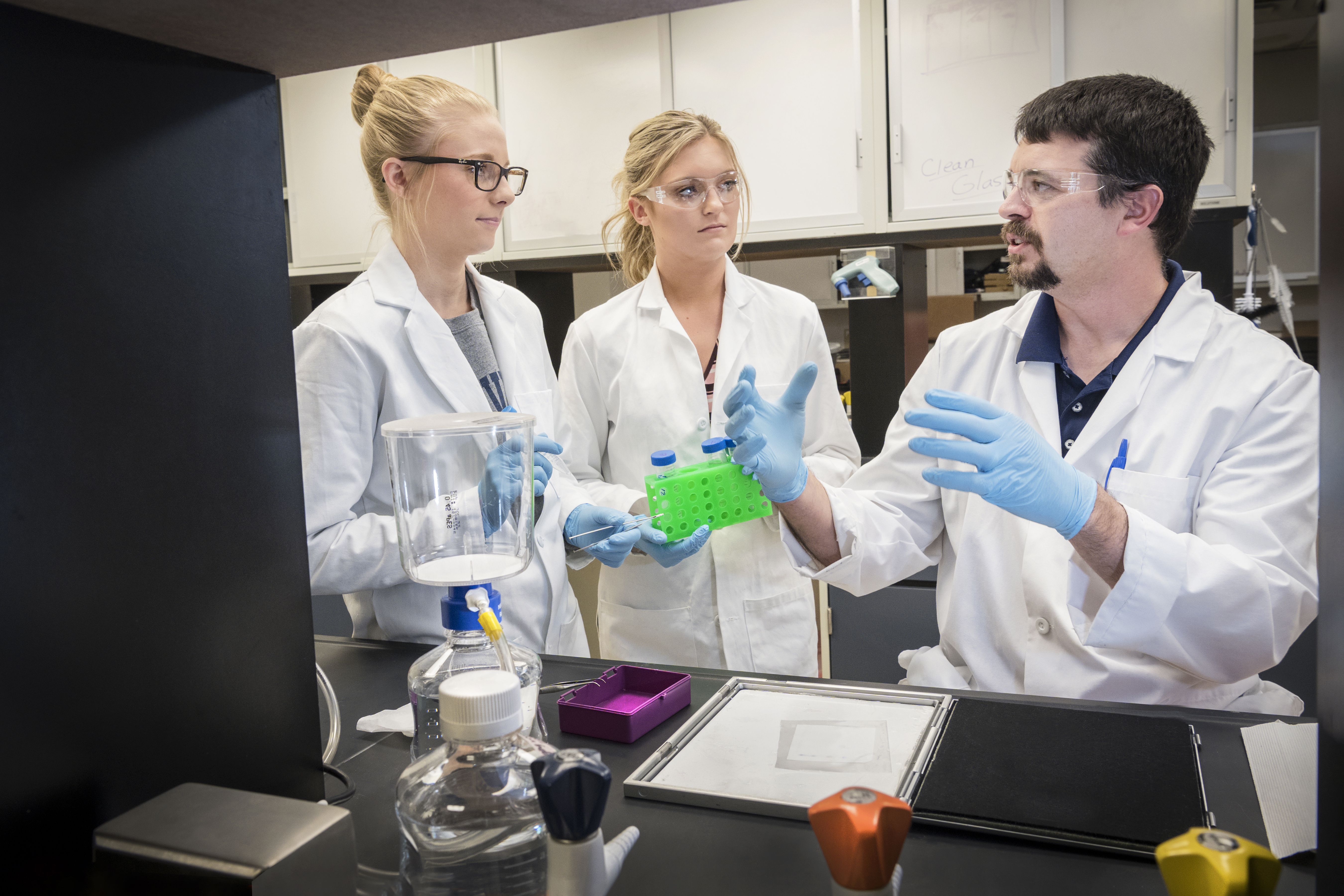WVU researcher receives NIH grant to explore effects of fracking on cardiovascular health

Photo: Travis Knuckles, assistant professor in the WVU School of Public Health, works with undergraduate research assistants (L to R) Allison Tolbert, a public-health major, and Haley Twilley, a recent graduate of the public-health program. Knuckles is studying the effects of fracking emissions on cardiovascular function. One goal of his NIH-funded project is “to involve students—especially undergraduates—in research where they wouldn’t typically be included,” he said.
Building and operating a hydraulic fracturing well site can emit airborne particles in multiple ways. But scientists still don’t fully understand how these particles impact human health.
Travis Knuckles, assistant professor in the West Virginia University School of Public Health, has received $450,000 from the National Institutes of Health to investigate these questions.
Hydraulic fracturing is a process in which oil and gas are extracted from rock by injecting mixtures of water, sand and chemicals underground. Over three years, Knuckles will explore how particulate matter in the air from fracking sites can make it harder for the body to control how much blood enters the capillaries, the narrowest blood vessels, and turn oxygen into ATP, a chemical that is a primary energy source for cells.
The particulate matter at the center of Knuckles’ study is especially fine. Each particle has a diameter of less than 2.5 micrometers. That’s smaller than a particle of talcum powder—even smaller than a red blood cell. Particles that small have been shown to cause cardiovascular disease, worsen its symptoms and make it more deadly.
“We have a pretty good idea of what particulate matter does in general,” said Knuckles, who is part of WVU’s Department of Occupational and Environmental Health Sciences and the WVU Health Sciences Center Toxicology Working Group. “The issue is that we have not looked at particulate matter from these gas wells as a toxicant unto itself. How is that emission different from a typical emission near a roadway? Is it more toxic than ambient particles in a broad sense?”
He and his research team will compare how airborne-particulate samples collected from the Marcellus Shale Energy and Environment Laboratory near Morgantown and from downtown Morgantown influence microvascular tissue.
Using pre-clinical models, they will examine whether the very fine particles that fracking releases are more toxic than the particles normally found in urban air. They will also study how the fracking-related particles’ toxicity decreases as the wind blows them away from the well site.
The team will pay special attention to whether the microvascular system can constrict or dilate properly when it’s exposed to very fine fracking-related particles. Knuckles predicts the particles will weaken dilation, cause inappropriately strong constrictions or both.
“The other thing that could be happening is that whatever exposure is taking place creates a condition where the mitochondria of the heart have decreased functionality. They’re just not as good at converting oxygen into ATP,” he said.
“This grant has offered us a great opportunity to look at the intersection of particle-exposure cardiac contractile function and bioenergetics,” said John Hollander, a member of the research team and exercise physiology professor in the WVU School of Medicine.
Hollander’s lab will focus on the molecular-level changes that fracking-related emissions trigger, whereas the WVU lab led by Timothy Nurkiewicz, another team member, will concern itself with vascular-level toxicology.
“This is a diverse team-science approach,” said Nurkiewicz, an associate chair of research and professor of physiology, pharmacology and neuroscience in the WVU School of Medicine. “Dr. Knuckles is taking a very important environmental challenge and using resources across the Health Sciences Center to assess what the health risks may be.”
The data that the project generates could be fodder for a larger epidemiological study in the future—which, in turn, could guide legislation that deals with where and how fracking occurs.
“What is the effect on physiology, and is that fact correlated pretty well in human data that come from these areas?” Knuckles asked. “I think we need science to inform policy in this case.”
Research discussed in this publication is supported by the National Institute of General Medical Sciences and the National Institute of Environmental Health Sciences, divisions of the National Institutes of Health, under Award Number 1R15ES028005.
-WVU-